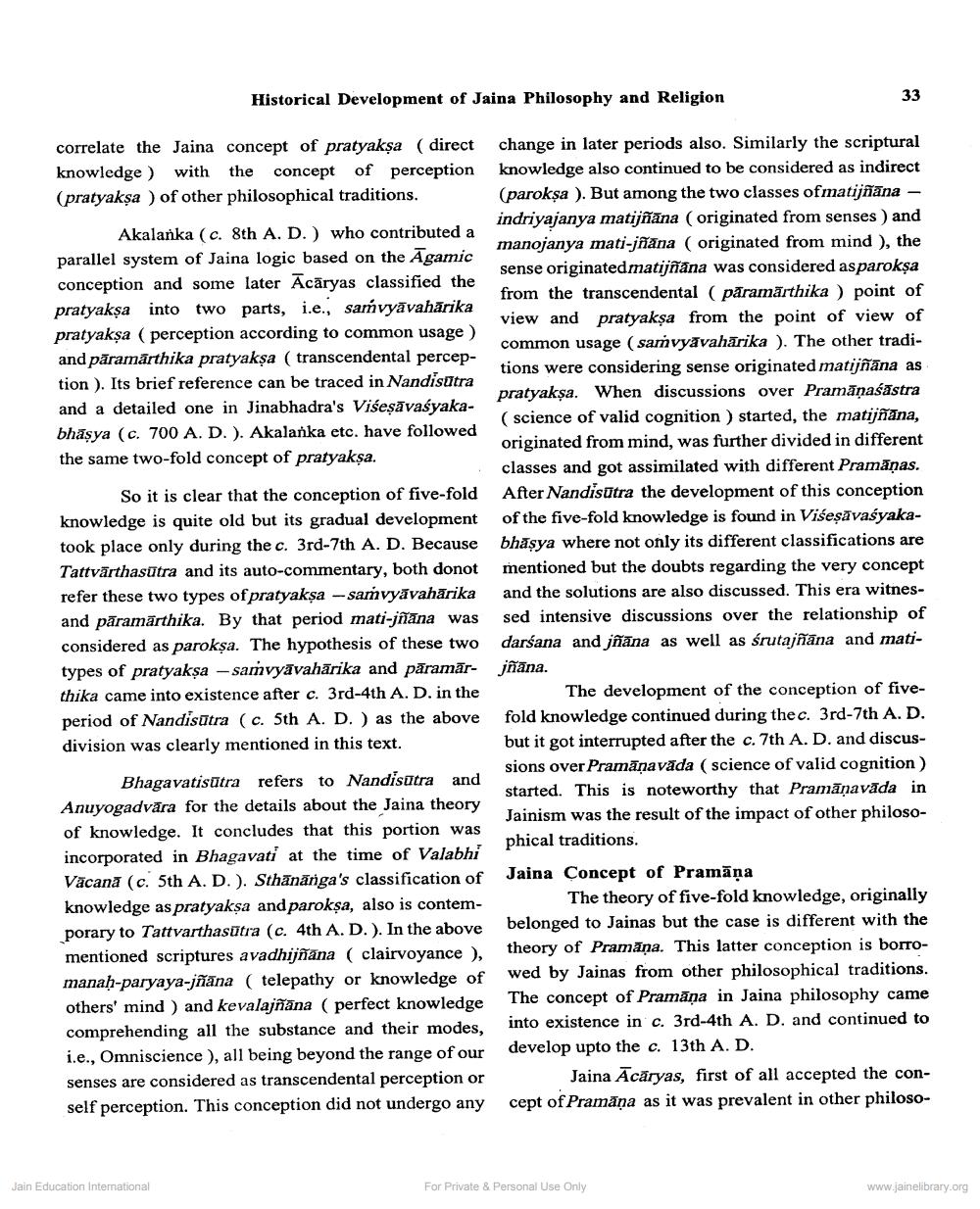________________
Historical Development of Jaina Philosophy and Religion
33
correlate the Jaina concept of pratyakșa ( direct change in later periods also. Similarly the scriptural knowledge ) with the concept of perception knowledge also continued to be considered as indirect (pratyakşa ) of other philosophical traditions.
(parokşa ). But among the two classes of matijñana -
indriyajanya matijñāna (originated from senses ) and Akalanka (c. 8th A. D.) who contributed a
manojanya mati-jñana (originated from mind ), the parallel system of Jaina logic based on the Āgamic conception and some later Acāryas classified the
sense originated matijñāna was considered asparokşa
from the transcendental (pāramārthika ) point of pratyakṣa into two parts, i.e. sarvyāvahärika
view and pratyakșa from the point of view of pratyakșa ( perception according to common usage )
common usage ( saṁvyāvahārika ). The other tradiand pāramārthika pratyaksa (transcendental percep
tions were considering sense originated matijñāna as tion ). Its brief reference can be traced in Nandisutra and a detailed one in Jinabhadra's Viseşāvasyaka
pratyakşa. When discussions over Pramāņaśāstra
( science of valid cognition ) started, the matijñana, bhasya (c. 700 A. D.). Akalanka etc. have followed
originated from mind, was further divided in different the same two-fold concept of pratyakşa.
classes and got assimilated with different Pramānas. So it is clear that the conception of five-fold After Nandisutra the development of this conception knowledge is quite old but its gradual development of the five-fold knowledge is found in Višeşāvasyakatook place only during the c. 3rd-7th A. D. Because bhāsya where not only its different classifications are Tattvārthasūtra and its auto-commentary, both donot mentioned but the doubts regarding the very concept refer these two types of pratyaksa-saṁvyāvahārika and the solutions are also discussed. This era witnesand pāramārthika. By that period mati-jñana was sed intensive discussions over the relationship of considered as parokşa. The hypothesis of these two darśana and jñāna as well as śrutajñāna and matitypes of pratyakṣa - samvyāvahārika and pāramār- jñana. thika came into existence after c. 3rd-4th A. D. in the
The development of the conception of fiveperiod of Nandisutra (c. 5th A. D. ) as the above fold knowledge continued during the c. 3rd-7th A. D. division was clearly mentioned in this text.
but it got interrupted after the c. 7th A. D. and discus
sions over Pramāņavāda (science of valid cognition) Bhagavatisātra refers to Nandisutra and
started. This is noteworthy that Pramāņavāda in Anuyogadvāra for the details about the Jaina theory
Jainism was the result of the impact of other philosoof knowledge. It concludes that this portion was
phical traditions. incorporated in Bhagavati at the time of Valabhi Vācana (c. 5th A. D.). Sthānānga's classification of Jaina Concept of Pramāņa knowledge as pratyakṣa and parokșa, also is contem
The then
The theory of five-fold knowledge, originally porary to Tattvarthasutra (c. 4th A. D.). In the above belonged to Jainas but the case is different with the mentioned scriptures avadhijñana ( clairvoyance), theory of Pramāņa. This latter conception is borromanah-paryaya-jñana (telepathy or knowledge of wed by Jainas from other philosophical traditions. others' mind ) and kevalajñāna (perfect knowledge The concept of Pramāņa in Jaina philosophy came comprehending all the substance and their modes,
into existence in c. 3rd 4th A. D. and continued to i.e., Omniscience ), all being beyond the range of our senses are considered as transcendental perception or
Jaina Ācāryas, first of all accepted the conself perception. This conception did not undergo any cept of Pramāņa as it was prevalent in other philoso
Jain Education International
For Private & Personal Use Only
www.jainelibrary.org




